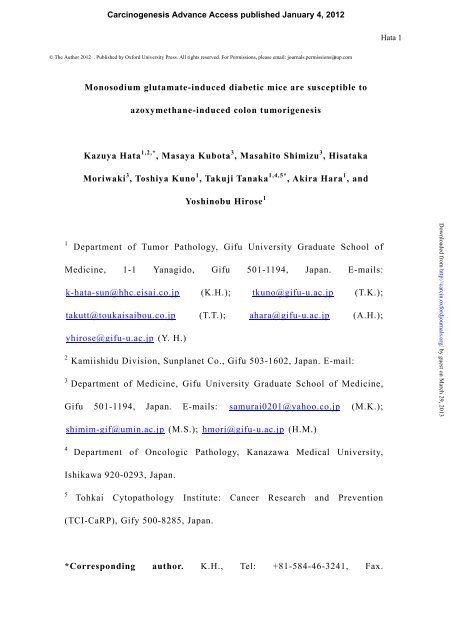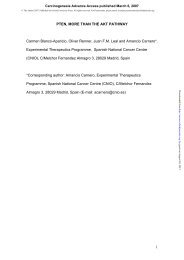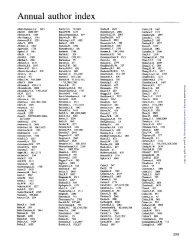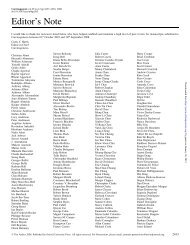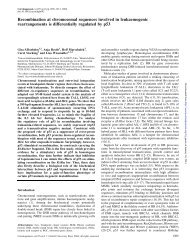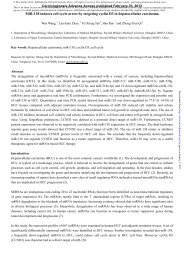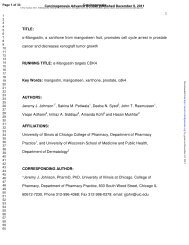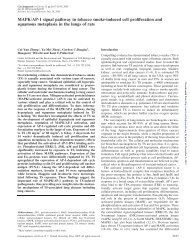Monosodium glutamate-induced diabetic mice are ... - Carcinogenesis
Monosodium glutamate-induced diabetic mice are ... - Carcinogenesis
Monosodium glutamate-induced diabetic mice are ... - Carcinogenesis
Create successful ePaper yourself
Turn your PDF publications into a flip-book with our unique Google optimized e-Paper software.
<strong>Carcinogenesis</strong> Advance Access published January 4, 2012<br />
© The Author 201 2 . Published by Oxford University Press. All rights reserved. For Permissions, please email: journals.permissions@ oup.com<br />
<strong>Monosodium</strong> <strong>glutamate</strong>-<strong>induced</strong> <strong>diabetic</strong> <strong>mice</strong> <strong>are</strong> susceptible to<br />
azoxymethane-<strong>induced</strong> colon tumorigenesis<br />
Kazuya Hata 1,2,* , Masaya Kubota 3 , Masahito Shimizu 3 , Hisataka<br />
Moriwaki 3 , Toshiya Kuno 1 , Takuji Tanaka 1,4,5* , Akira Hara 1 , and<br />
Yoshinobu Hirose 1<br />
1 Department of Tumor Pathology, Gifu University Graduate School of<br />
Medicine, 1-1 Yanagido, Gifu 501-1194, Japan. E-mails:<br />
k-hata-sun@hhc.eisai.co.jp (K.H.); tkuno@gifu-u.ac.jp (T.K.);<br />
takutt@toukaisaibou.co.jp (T.T.); ahara@gifu-u.ac.jp (A.H.);<br />
yhirose@gifu-u.ac.jp (Y. H.)<br />
2 Kamiishidu Division, Sunplanet Co., Gifu 503-1602, Japan. E-mail:<br />
3 Department of Medicine, Gifu University Graduate School of Medicine,<br />
Gifu 501-1194, Japan. E-mails: samurai0201@yahoo.co.jp (M.K.);<br />
shimim-gif@umin.ac.jp (M.S.); hmori@gifu-u.ac.jp (H.M.)<br />
4 Department of Oncologic Pathology, Kanazawa Medical University,<br />
Ishikawa 920-0293, Japan.<br />
5 Tohkai Cytopathology Institute: Cancer Research and Prevention<br />
(TCI-CaRP), Gify 500-8285, Japan.<br />
*Corresponding author. K.H., Tel: +81-584-46-3241, Fax.<br />
Hata 1<br />
Downloaded from<br />
http://carcin.oxfordjournals.org/ by guest on March 29, 2013
+81-584-48-0011. E-mail: k-hata-sun@hhc.eisai.co.jp; and T.T., Tel:<br />
+81-50-273-4399, Fax: +81-58-273-4392, E-mail:<br />
takutt@toukaisaibou.co.jp<br />
Hata 2<br />
Downloaded from<br />
http://carcin.oxfordjournals.org/<br />
by guest on March 29, 2013
Abstract<br />
Obese people and <strong>diabetic</strong> patients <strong>are</strong> known to be high risk of<br />
colorectal cancer (CRC), suggesting need of a new preclinical animal model,<br />
by which to extensively study the diverse mechanisms, therapy, and<br />
prevention. The present study aimed to determine whether experimental<br />
obese and <strong>diabetic</strong> <strong>mice</strong> produced by monosodium <strong>glutamate</strong> (MSG)<br />
treatment <strong>are</strong> susceptible to azoxymethane (AOM)-<strong>induced</strong> colon<br />
tumorigenesis using early biomarkers, aberrant crypts foci (ACF) and<br />
β-catenin-accumulated crypts (BCAC), of colorectal carcinogenesis. Male<br />
Crj:CD-1 (ICR) newborns were daily given four subcutaneous injections of<br />
MSG (2 mg/g body weight) to induce diabetes and obesity. They were then<br />
given four intraperitoneal injections of AOM (15 mg/kg body weight) or<br />
saline (0.1 ml saline/10 g body weight). Ten weeks after the last injection of<br />
AOM, the MSG-AOM <strong>mice</strong> had a significant increase in the multiplicity of<br />
BCAC (13.83±7.44, p
highly susceptible to AOM-<strong>induced</strong> colorectal carcinogenesis, suggesting<br />
potential utility of our MSG-AOM <strong>mice</strong> for further investigation of the<br />
possible underlying events that affect the positive association between<br />
obese/diabetes and CRC.<br />
(274 words).<br />
Key words: type 2 diabetes mellitus; monosodium <strong>glutamate</strong>; azoxymethane,<br />
pre-cancerous colonic lesions; Crj:CD-1 (ICR) <strong>mice</strong>.<br />
Hata 4<br />
Downloaded from<br />
http://carcin.oxfordjournals.org/ by guest on March 29, 2013
Introduction<br />
Epidemiological studies have shown that obesity and diabetes mellitus<br />
may be one of the risk factors for colorectal cancer (CRC) development<br />
[1-7]. At present, hyperinsulinemia [8,9], hypercholesterolemia [10,11],<br />
hyperglycemia [9,12], hyperlipidemia [7] <strong>are</strong> considered to be possible risk<br />
factors of CRC. In addition, insulin-like growth factor (IGF) pathway is<br />
involved in colorectal carcinoagenesis [13-16] and the signaling pathway<br />
is .reported to be a potential target of CRC treatment [17-19] and CRC<br />
chemoprevention [20,21]. Thus, importance of the growth hormone/IGF-1<br />
axis [22] and IGF/IGF-1 receptor (IGF-1R) axis [15,23,24] is postulated in<br />
carcinogenesis in CRC development. In fact, our experimental studies<br />
indicated that the IGF/IGF-1R axis is altered during carcinogenesis in<br />
colorectum [25,26] and other tissue [27,28] and the axis is a good target for<br />
cancer chemoprevention [25-28]. However, the underlying mechanisms of<br />
how these chronic diseases promote colon carcinogenesis still remain<br />
unknown [19]. On this context new research animal models <strong>are</strong> needed to<br />
investigate the diverse aspects of the mechanisms.<br />
We have previously reported that development of AOM-<strong>induced</strong><br />
pre-cancerous lesions is enhanced in C57BL/KsJ-db/db <strong>mice</strong> with<br />
hyperleptinemia and hyperinsulinemia [29]. Such an animal model may give<br />
important implications for further exploration of the possible underlying<br />
events that affect the positive association between CRC and obesity and/or<br />
Hata 5<br />
Downloaded from<br />
http://carcin.oxfordjournals.org/ by guest on March 29, 2013
diabetes [30-32]. A number of animal models for diabetes and/or obesity<br />
have been reported. One such model is produced by injection of<br />
monosodium <strong>glutamate</strong> (MSG). When MSG is applied to Crj:CD-1 (ICR)<br />
newborn <strong>mice</strong> (MSG <strong>mice</strong>), they develop <strong>diabetic</strong> condition<br />
(hyperinsulinemia, hyperglycemia and hyperplastic islets) without<br />
polyphagia [33,34].<br />
It is believed that colorectal carcinogenesis is a representative<br />
multi-step tumorigenesis with events of genetic alterations, Several small<br />
lesions, including aberrant crypt foci (ACF) [35,36], mucin-depleted foci<br />
(MDF) [37], and β-catenin-accumulated crypts (BCAC) [38], <strong>are</strong> proposed<br />
as early-appearing pre-neoplastic lesions [37]. While ACF and MDF <strong>are</strong><br />
recognized on the surface of cancer-predisposed colons of rodents and<br />
human [37], BCAC <strong>are</strong> identified in colonic mucosa at the early stages of<br />
colon carcinogenesis [39]. Accumulating evidence suggests that BCAC <strong>are</strong><br />
independent small dysplastic lesions and/or microadenomas and progressed<br />
pre-cancerous lesions [40] in colon carcinogenesis when comp<strong>are</strong>d ACF and<br />
MDF [39]. These early lesions <strong>are</strong> widely used for investigating<br />
pathobiology of colorectal carcinogenesis [37].<br />
In the current study, new born Crj:CD-1 (ICR) <strong>mice</strong> were treated with<br />
MSG to produce diabetes and obesity, and subsequently they received a<br />
colonic carcinogen, azoxymethane (AOM). Our results indicated that the<br />
MSG <strong>mice</strong> <strong>are</strong> highly susceptible to AOM-<strong>induced</strong> colorectal carcinogenesis<br />
Hata 6<br />
Downloaded from<br />
http://carcin.oxfordjournals.org/ by guest on March 29, 2013
y counting the number of BCAC, but not ACF, and possible involvement of<br />
the IGF/IGF-1R axis in colorectal tumorigenesis of <strong>diabetic</strong> and obese <strong>mice</strong><br />
<strong>induced</strong> by MSG and AOM. Our main goal is to assess the involvement of<br />
obesity/diabetes-associated events, such as hyperinsulinemia, in colorectal<br />
carcinogenesis in vivo.<br />
Materials and Methods<br />
Animals and chemicals<br />
The pregnant Crj:CD-1 (ICR) <strong>mice</strong> were purchased from Charles River<br />
Japan, Inc. (Kanagawa, Japan) and their newborns were used in the study.<br />
MSG was obtained from Wako Pure Chemical Industries, Ltd. (Tokyo,<br />
Japan) and AOM from Sigma Chemical Co. (St. Louis, MO, USA). Mice<br />
used for the experiment were maintained in the well-controlled room with a<br />
high-efficiency particulate air (HEPA) filter, a 12h lighting (7:00-19:00),<br />
25±2°C room temperature, and 55±15% humidity. Mice (3-6 <strong>mice</strong>/cage)<br />
were housed in polycarbonate cages measuring W225 x D338 x H140 mm<br />
(Japan CLEA, Inc. (Tokyo, Japan) with the floor covered with a sheet of roll<br />
paper (Japan SLC). MF (Oriental Yeast Co., Ltd., Tokyo, Japan) was used as<br />
a basal diet throughout the study. Groundwater that was chlorine-treated and<br />
subjected to ultraviolet disinfection was used as drinking water in a bottle.<br />
We fully complied with the “Guidelines Concerning Experimental Animals”<br />
Hata 7<br />
Downloaded from<br />
http://carcin.oxfordjournals.org/ by guest on March 29, 2013
issued by the Japanese Association for Laboratory Animal Science and<br />
exercised due consideration so as not to cause any ethical problem.<br />
Experimental procedure<br />
The newborns were divided into two groups according to the treatments.<br />
The birth date was the beginning of four daily subcutaneous injections of<br />
MSG (2 mg/g body weight, MSG <strong>mice</strong>) and physiological saline (Saline<br />
<strong>mice</strong>). Among these <strong>mice</strong>, males were subjected to the study. They were<br />
divided into four groups at 4 weeks of age: groups 1 (12 males) and 2 (6<br />
males) of the MSG <strong>mice</strong> received four weekly intraperitoneal injections of<br />
AOM (15 mg/kg body weight, the MSG-AOM <strong>mice</strong>) and physiological<br />
saline (0.1 ml/10g body weight, the MSG-Saline <strong>mice</strong>), respectively.<br />
Similarly, two groups of the ICR-Saline <strong>mice</strong> were given AOM or saline,<br />
belonging to groups 3 (11 males, the Saline-AOM <strong>mice</strong>) and 4 (5 males, the<br />
Saline-Saline). At the termination of the experiment (10 weeks after the last<br />
injection of AOM and 17 weeks of age of <strong>mice</strong>), all animals were sacrificed<br />
to analyze the number of colonic ACF and BCAC, clinical serum chemistry,<br />
and mRNA expression of IGF1, IGF2, and IGF-1R in the colonic mucosa.<br />
Counting the numbers of ACF and BCAC<br />
The ACF and BCAC were determined according to the standard<br />
procedures described previously [30,31,41]. ACF <strong>are</strong> defined as single or<br />
Hata 8<br />
Downloaded from<br />
http://carcin.oxfordjournals.org/ by guest on March 29, 2013
multiple crypts that have altered luminal openings, exhibit thickened<br />
epithelia and <strong>are</strong> larger than adjacent normal crypts [35]. BCAC, which<br />
have high frequency mutations in β-catenin gene, demonstrate histological<br />
dysplasia with a disruption of the cellular morphology and an accumulation<br />
of this protein (Fig. 2B) [39]. BCAC do not have a typical ACF-like<br />
appearance because the lesion is not recognized on the mucosal surface like<br />
ACF, and is only identified in the histological sections of en face<br />
preparations. Both of these lesions <strong>are</strong> utilized as biomarkers to evaluate a<br />
number of agents for their potential chemopreventive [42-44] and<br />
tumor-promotion [45] properties. After the colons were fixed flat in 10%<br />
buffered formalin for 24 hours, the mucosal surface of the colons were<br />
stained with methylene blue (0.5% in distilled water) and then the number<br />
of ACF were counted under a light microscope. Thereafter, the distal parts<br />
(5 cm from anus) of the colon were cut to count the number of BCAC. To<br />
identify BCAC intramucosal lesions, the distal part of the colon (mean <strong>are</strong>a:<br />
0.7 cm 2 /colon) was embedded in paraffin and then a total of 20 serial<br />
sections (4-μ m thick each) per colon were made by an en face preparation<br />
[30,31,41]. For each case, 2 serial sections were used to analyze BCAC.<br />
Histopathology and immunohistochemical analyses for β-catenin and<br />
IGF-1R<br />
Three serial sections were made from paraffin-embedded tissue blocks.<br />
Hata 9<br />
Downloaded from<br />
http://carcin.oxfordjournals.org/ by guest on March 29, 2013
Two sections were subjected to hematoxylin and eosin (H & E) staining for<br />
histopathology and β-catenin immunohistochemistry to count the number of<br />
BCAC. Immunohistochemistry for β-catenin and IGF-1R was performed<br />
using the labeled streptavidin-biotin method (LSAB kit; DAKO, Glostrup,<br />
Denmark), as previously described [30,31]. Primary antibodies of<br />
anti- β-catenin antibody (1:1000 final dilution) and anti-IGF-1R antibody<br />
(1:100 final dilution) obtained from Transduction Laboratories (catalog no.<br />
610154; San Jose, CA) and Santa Cruz Biotechnology, Inc. (sc-7907; Santa<br />
Cruz, CA), respectively, were applied on the sections. Negative control<br />
sections were immunostained without the primary antibody.<br />
Blood chemistry<br />
At 17 weeks of age, blood samples (0.5-1.0 ml/mouse) were collected<br />
for determination of total cholesterol, triglyceride and glucose by a simple<br />
measurement device (DRICHEM Fujifilm Medical Co., Ltd., Tokyo). The<br />
concentration of blood insulin was measured by a LBIS insulin measuring<br />
kit for <strong>mice</strong> (Shibayagi Co., Ltd., Gunma).<br />
RNA extraction and quantitative real-time RT-PCR analysis<br />
A quantitative real-time RT-PCR analysis was carried out in the scraped<br />
colonic mucosa of the MSG-AOM <strong>mice</strong> and the Salin-AOM <strong>mice</strong>. Total RNA<br />
was isolated from the the scraped colon mucosa of the <strong>mice</strong> using the<br />
Hata 10<br />
Downloaded from<br />
http://carcin.oxfordjournals.org/ by guest on March 29, 2013
RNAqueous-4PCR kit (Ambion Applied Biosystems, Austin, TX, USA). The<br />
cDNA was synthesized from 0.2 μg total RNA using the SuperScript III<br />
First-Strand Synthesis System (Invitrogen, Carlsbad, CA, USA). The primers<br />
used for the amplification of IGF-1, IGF-2, and IGF-1R specific genes were<br />
as follows: IGF-1 forward, 5-CTGGACCAGAGACCCTTTGC-3 and reverse,<br />
5-GGACGGGGACTTCTGAGTCTT-3; IGF-2 forward,<br />
5-GTGCTGCATCGCTGCTTAC-3 and reverse,<br />
5-ACGTCCCTCTCGGACTTGG-3; and IGF-1R forward,<br />
5-GTGGGGGCTCGTGTTTCTC-3 and reverse,<br />
5-GATCACCGTGCAGTTTTCCA-3. Real-time PCR was done in a<br />
LightCycler (Roche Diagnostics Co., Indianapolis, IN, USA) with SYBR<br />
Premix Ex Taq (TaKaRa Bio, Shiga, Japan). The expression levels of the<br />
IGF-1, IGF-2, and IGF-1R genes were normalized to the β-actin gene<br />
expression level.<br />
Statistical analysis<br />
Measurements <strong>are</strong> expressed as mean ± SD, and differences if present<br />
were comp<strong>are</strong>d by one-way analysis of ANOVA (Tukey-Kramer’s multiple<br />
comparison’s test) or two-tailed unpaired t-test. The incidences of intestinal<br />
tumors were comp<strong>are</strong>d by Fisher’s exact probability test. The results were<br />
considered statistically significant if the p values were
Results<br />
General observations<br />
As shown in Fig. 1, the mean body weight of MSG-Saline <strong>mice</strong> (group 2)<br />
was much greater than Saline-Saline <strong>mice</strong> (group 4) during the study. The<br />
average body weights of the AOM-injected groups belonging to groups 1<br />
(MSG-AOM) and 3 (Saline-AOM) were smaller than that of saline-injected<br />
groups, groups 2 (MSG-Saline) and 4 (Saline-Saline), during the study. At<br />
the termination of the experiment the mean body weights of groups 1 and 3<br />
were significantly lower than groups 2 and 4, respectively (p
Serum levels of glucose, total cholesterol, triglyceride and insulin<br />
The serum concentrations of glucose, total cholesterol, triglyceride, and<br />
insulin at 17 weeks of age <strong>are</strong> shown in Table 2. MSG treatment<br />
significantly elevated all measures regardless of the AOM exposure (group<br />
1 vs. group 3, p
81-fold increase) and IRF-1R (2.43-fold increase), when comp<strong>are</strong>d to the<br />
Saline-AOM <strong>mice</strong>. The increase of IGF-1R was statistically significant<br />
(p
gene mutations, <strong>are</strong> demonstrated in human ACF [46-48]. BCAC, which<br />
accumulate β-catenin protein in the nucleus and cytoplasm, <strong>are</strong> also<br />
regarded as putative precursors to colorectal adenomas [37]. Several rodent<br />
studies have shown that both of these lesions <strong>are</strong> useful as biomarkers to<br />
evaluate the chemopreventive properties of specific agents [49,50]. In<br />
human colorectum, increased plasma IGF-1 levels <strong>are</strong> associated with the<br />
number of dysplastic ACF [51], suggesting that IGF-1 may be a promoter of<br />
the growth of dysplastic ACF and an independent risk factor of CRC. It may<br />
be possible that the number of dysplastic ACF, but not hyperplastic ACF,<br />
may be increased in the MSG-AOM <strong>mice</strong>, although we did not analyze two<br />
types of ACF.<br />
Neonatal injections of MSG to <strong>mice</strong> or rats cause hyperthalamic damage<br />
[52,53], and as a consequence, these animals present several<br />
neuroendocrine and metabolic alterations, which lead central obesity, type 2<br />
diabetes, insulin resistance, hyperinsulinemia, hypertriglyceridemia, and<br />
hyperlipidemia [33]. These abnormalities <strong>are</strong> risks for the development of<br />
CRC [9]. The pancreatic islets in the <strong>mice</strong> subcutaneously injected MSG in<br />
neonatal period <strong>are</strong> hyperplastic up to 54 weeks of age [33]. Therefore, .our<br />
model described here may be suitable to study the pathobiology of diabetes-<br />
and obesity-asosciated colorectal carcinogenesis.<br />
In this study, blood insulin level of the MSG-Saline <strong>mice</strong> (group 2) was<br />
the highest among the groups. There is accumulating evidence suggesting<br />
Hata 15<br />
Downloaded from<br />
http://carcin.oxfordjournals.org/ by guest on March 29, 2013
that hyperinsulinemia is involved in colon carcinogenesis, obesity, and<br />
diabetes [3,8,9,12,54,55]. Several epidemiological studies indicate that type<br />
2 <strong>diabetic</strong> patients with hyperinsulinemia increases risk for CRC [3,12].<br />
Additionally, continuous injections of insulin promote AOM-<strong>induced</strong> colon<br />
carcinogenesis in rats [56,57]. Hence, it seems likely that hyperinsulinemia<br />
in the MSG-AOM <strong>mice</strong> enhanced the development of AOM-<strong>induced</strong> lesions<br />
in the present study. Hyperglycemia and hypercholesterolemia observed in<br />
the MSG-AOM <strong>mice</strong> also contribute the development of BCAC and ACF in<br />
the colorectum, since these conditions <strong>are</strong> positively associated with CRC<br />
occurrence [9,11,12]. Hyperinsulinemia, hyperglycemia and<br />
hypercholesterolemia may singly or synergistically promote the<br />
development of preneoplastic and neoplastic colonic lesions. Although<br />
insulin resistance in colorectal carcinogenesis of obese people and/or type 2<br />
<strong>diabetic</strong> patients is reported [7,55,58,59], we did not investigate presence or<br />
absence of insulin resistance in this study, Corpet et al. reportted that diet<br />
that increase some indirect insulin resistance markers does not promote<br />
colon carcinogenesis in female rats when ACF <strong>are</strong> used as a biomarker [60].<br />
Regarding the mode of action, the current consensus assumes that the<br />
IGF-1 pathway plays a role in insulin-related tumor promotion in the colon<br />
[20,61]. IGF-1 binds to the IGF-1R, activates a signal cascade and triggers<br />
cell proliferation in several tissues, including colon [62]. Insulin at<br />
supra-physiological levels also binds to and activates the IGF-1R because of<br />
Hata 16<br />
Downloaded from<br />
http://carcin.oxfordjournals.org/ by guest on March 29, 2013
its homology with the insulin receptor [62]. Furthermore, hyperinsulinemia<br />
was shown to indirectly increase bioavailability of IGF-1 by regulating<br />
levels of IGF-binding proteins [63]. In this study, IGF-1R<br />
immunohistochemical expression of IGF-1 was strongly positive in the<br />
cytoplasm of BCAC developed in the MSG-AOM <strong>mice</strong>. Indeed,<br />
over-expression of IGF-1R was also reported in human CRC [64].<br />
Accordingly, it may be possible that hyperinsulinemia in MSG-AOM <strong>mice</strong><br />
activates the signaling cascades involving the IGF-IR, resulting in a<br />
proliferative response [19,59,61]. Another interesting findings regarding<br />
IGF-1R immunohistochemistry is that inflammatory cells infiltrated around<br />
BCAC were positively reacted against the IGF-1R antibody. Significance of<br />
the findings is not known, but similar findings have been reported in human<br />
Crohn’s disease [65]. IGF-1 and IGF2 <strong>are</strong> potentially relevant mediators in<br />
the chronic inflammation [27] and mediate the majority of their biological<br />
action through IGF-1R [66]. Thus, our findings on the IGF-1R<br />
immunohistochemical positivity in inflammatory cells suggest that<br />
inflammation in the microenvironment of pre-cancerous lesions for CRC<br />
may .contribute to the growth of the lesions [67,68].<br />
In conclusion, our data indicate that the MSG-AOM <strong>mice</strong> with<br />
hyperinsulinemia hypercholesterolemia, hyperglycemia, and<br />
hypercholesterolemia <strong>are</strong> highly susceptible to colorectal carcinogenesis<br />
and the MSG-AOM mouse model could be useful for investigating the<br />
Hata 17<br />
Downloaded from<br />
http://carcin.oxfordjournals.org/ by guest on March 29, 2013
mechanisms of obesity/diabetes-associated events involving in colorectal<br />
carcinogenesis and the therapeutic and chemopreventive strategies of CRC<br />
in obese people and/or type 2 <strong>diabetic</strong> patients.<br />
Acknowledgments<br />
We wish to thank Kyoko Takahashi and Ayako Suga for their technical<br />
assistance, and Yoshitaka Kinjo for c<strong>are</strong> of the animals. This work was<br />
supported in part by a Grant-in-Aid from the Ministry of Health, Labour, and<br />
Welf<strong>are</strong> of Japan (to Y.H.); a Grant-in-Aid for the 3rd Term Comprehensive<br />
10-Year Strategy for Cancer Control from the Ministry of Health, Labour and<br />
Welf<strong>are</strong> of Japan (to T.T.); a Grant-in-Aid for Cancer Research from the<br />
Ministry of Health, Labour and Welf<strong>are</strong> of Japan; and Grants-in-Aid for<br />
Scientific Research (No. 23501324) from the Ministry of Education, Culture,<br />
Sports, Science and Technology of Japan (to T.T.);<br />
Hata 18<br />
Downloaded from<br />
http://carcin.oxfordjournals.org/ by guest on March 29, 2013
References<br />
1. Bergstrom, A., Pisani, P., Tenet, V., Wolk, A. and Adami, H.O. (2001)<br />
Overweight as an avoidable cause of cancer in Europe. Int J Cancer, 91,<br />
421-30.<br />
2. Murphy, T.K., Calle, E.E., Rodriguez, C., Kahn, H.S. and Thun, M.J.<br />
(2000) Body mass index and colon cancer mortality in a large prospective<br />
study. Am J Epidemiol, 152, 847-54.<br />
3. Berster, J.M. and Goke, B. (2008) Type 2 diabetes mellitus as risk factor<br />
for colorectal cancer. Arch Physiol Biochem, 114, 84-98.<br />
4. Craigie, A.M., Caswell, S., Paterson, C., Treweek, S., Belch, J.J., Daly, F.,<br />
Rodger, J., Thompson, J., Kirk, A., Ludbrook, A., Stead, M., Wardle, J.,<br />
Steele, R.J. and Anderson, A.S. (2011) Study protocol for BeWEL: the<br />
impact of a BodyWEight and physicaL activity intervention on adults at<br />
risk of developing colorectal adenomas. BMC Public Health, 11, 184.<br />
5. Morita, T., Tabata, S., Mineshita, M., Mizoue, T., Moore, M.A. and Kono,<br />
S. (2005) The metabolic syndrome is associated with increased risk of<br />
colorectal adenoma development: the Self-Defense Forces health study.<br />
Asian Pac J Cancer Prev, 6, 485-9.<br />
6. Nilsen, T.I. and Vatten, L.J. (2001) Prospective study of colorectal cancer<br />
risk and physical activity, diabetes, blood glucose and BMI: exploring the<br />
hyperinsulinaemia hypothesis. Br J Cancer, 84, 417-22.<br />
7. Takahashi, H., Yoneda, K., Tomimoto, A., Endo, H., Fujisawa, T., Iida, H.,<br />
Hata 19<br />
Downloaded from<br />
http://carcin.oxfordjournals.org/ by guest on March 29, 2013
Mawatari, H., Nozaki, Y., Ikeda, T., Akiyama, T., Yoneda, M., Inamori, M.,<br />
Abe, Y., Saito, S., Nakajima, A. and Nakagama, H. (2007) Life<br />
style-related diseases of the digestive system: colorectal cancer as a life<br />
style-related disease: from carcinogenesis to medical treatment. J<br />
Pharmacol Sci, 105, 129-32.<br />
8. Giouleme, O., Diamantidis, M.D. and Katsaros, M.G. (2011) Is diabetes a<br />
causal agent for colorectal cancer? Pathophysiological and molecular<br />
mechanisms. World J Gastroenterol, 17, 444-8.<br />
9. Siddiqui, A.A. (2011) Metabolic syndrome and its association with<br />
colorectal cancer: a review. Am J Med Sci, 341, 227-31.<br />
10. Canani, R.B., Costanzo, M.D., Leone, L., Pedata, M., Meli, R. and<br />
Calignano, A. (2011) Potential beneficial effects of butyrate in intestinal<br />
and extraintestinal diseases. World J Gastroenterol, 17, 1519-28.<br />
11. Herbey, II, Ivankova, N.V., Katkoori, V.R. and Mamaeva, O.A. (2005)<br />
Colorectal cancer and hypercholesterolemia: review of current research.<br />
Exp Oncol, 27, 166-78.<br />
12. Chang, C.K. and Ulrich, C.M. (2003) Hyperinsulinaemia and<br />
hyperglycaemia: possible risk factors of colorectal cancer among <strong>diabetic</strong><br />
patients. Diabetologia, 46, 595-607.<br />
13. Davies, M., Gupta, S., Goldspink, G. and Winslet, M. (2006) The<br />
insulin-like growth factor system and colorectal cancer: clinical and<br />
experimental evidence. Int J Colorectal Dis, 21, 201-8.<br />
Hata 20<br />
Downloaded from<br />
http://carcin.oxfordjournals.org/ by guest on March 29, 2013
14. Durai, R., Yang, W., Gupta, S., Seifalian, A.M. and Winslet, M.C. (2005)<br />
The role of the insulin-like growth factor system in colorectal cancer:<br />
review of current knowledge. Int J Colorectal Dis, 20, 203-20.<br />
15. Sandhu, M.S., Dunger, D.B. and Giovannucci, E.L. (2002) Insulin,<br />
insulin-like growth factor-I (IGF-I), IGF binding proteins, their biologic<br />
interactions, and colorectal cancer. J Natl Cancer Inst, 94, 972-80.<br />
16. LeRoith, D. and Roberts, C.T., Jr. (2003) The insulin-like growth factor<br />
system and cancer. Cancer Lett, 195, 127-37.<br />
17. Ewing, G.P. and Goff, L.W. (2010) The insulin-like growth factor signaling<br />
pathway as a target for treatment of colorectal carcinoma. Clin Colorectal<br />
Cancer, 9, 219-23.<br />
18. Golan, T. and Javle, M. (2011) Targeting the insulin growth factor pathway<br />
in gastrointestinal cancers. Oncology (Williston Park), 25, 518-26, 529.<br />
19. Ludwig, J.A., Lamhamdi-Cherradi, S.-E., Lee, H.-Y., Naing, A. and<br />
Benjamin, R. (2011) Dual targeting of the Insulin-like growth factor and<br />
collateral pathways in cancer: Combating drug resistance. Cancers, 3,<br />
3029-3054.<br />
20. Shimizu, M., Adachi, S., Masuda, M., Kozawa, O. and Moriwaki, H. (2011)<br />
Cancer chemoprevention with green tea catechins by targeting receptor<br />
tyrosine kinases. Mol Nutr Food Res, 55, 832-43.<br />
21. Voskuil, D.W., Vrieling, A., van't Veer, L.J., Kampman, E. and Rookus,<br />
M.A. (2005) The insulin-like growth factor system in cancer prevention:<br />
Hata 21<br />
Downloaded from<br />
http://carcin.oxfordjournals.org/ by guest on March 29, 2013
potential of dietary intervention strategies. Cancer Epidemiol Biomarkers<br />
Prev, 14, 195-203.<br />
22. Bustin, S.A. and Jenkins, P.J. (2001) The growth hormone-insulin-like<br />
growth factor-I axis and colorectal cancer. Trends Mol Med, 7, 447-54.<br />
23. Haydon, A.M., Macinnis, R.J., English, D.R., Morris, H. and Giles, G.G.<br />
(2006) Physical activity, insulin-like growth factor 1, insulin-like growth<br />
factor binding protein 3, and survival from colorectal cancer. Gut, 55,<br />
689-94.<br />
24. Renehan, A.G., Zwahlen, M., Minder, C., O'Dwyer, S.T., Shalet, S.M. and<br />
Egger, M. (2004) Insulin-like growth factor (IGF)-I, IGF binding protein-3,<br />
and cancer risk: systematic review and meta-regression analysis. Lancet,<br />
363, 1346-53.<br />
25. Shimizu, M., Shirakami, Y., Iwasa, J., Shiraki, M., Yasuda, Y., Hata, K.,<br />
Hirose, Y., Tsurumi, H., Tanaka, T. and Moriwaki, H. (2009)<br />
Supplementation with branched-chain amino acids inhibits<br />
azoxymethane-<strong>induced</strong> colonic preneoplastic lesions in male<br />
C57BL/KsJ-db/db <strong>mice</strong>. Clin Cancer Res, 15, 3068-75.<br />
26. Shimizu, M., Shirakami, Y., Sakai, H., Adachi, S., Hata, K., Hirose, Y.,<br />
Tsurumi, H., Tanaka, T. and Moriwaki, H. (2008) (-)-Epigallocatechin<br />
gallate suppresses azoxymethane-<strong>induced</strong> colonic premalignant lesions in<br />
male C57BL/KsJ-db/db <strong>mice</strong>. Cancer Prev Res (Phila), 1, 298-304.<br />
27. Shimizu, M., Sakai, H., Shirakami, Y., Yasuda, Y., Kubota, M., Terakura,<br />
Hata 22<br />
Downloaded from<br />
http://carcin.oxfordjournals.org/ by guest on March 29, 2013
D., Baba, A., Ohno, T., Hara, Y., Tanaka, T. and Moriwaki, H. (2011)<br />
Preventive effects of (-)-epigallocatechin gallate on<br />
diethylnitrosamine-<strong>induced</strong> liver tumorigenesis in obese and <strong>diabetic</strong><br />
C57BL/KsJ-db/db Mice. Cancer Prev Res (Phila), 4, 396-403.<br />
28. Shimizu, M., Shirakami, Y., Sakai, H., Tatebe, H., Nakagawa, T., Hara, Y.,<br />
Weinstein, I.B. and Moriwaki, H. (2008) EGCG inhibits activation of the<br />
insulin-like growth factor (IGF)/IGF-1 receptor axis in human<br />
hepatocellular carcinoma cells. Cancer Lett, 262, 10-8.<br />
29. Hirose, Y., Hata, K., Kuno, T., Yoshida, K., Sakata, K., Yamada, Y., Tanaka,<br />
T., Reddy, B.S. and Mori, H. (2004) Enhancement of development of<br />
azoxymethane-<strong>induced</strong> colonic premalignant lesions in C57BL/KsJ-db/db<br />
<strong>mice</strong>. <strong>Carcinogenesis</strong>, 25, 821-5.<br />
30. Suzuki, R., Kohno, H., Yasui, Y., Hata, K., Sugie, S., Miyamoto, S.,<br />
Sugawara, K., Sumida, T., Hirose, Y. and Tanaka, T. (2007) Diet<br />
supplemented with citrus unshiu segment membrane suppresses chemically<br />
<strong>induced</strong> colonic preneoplastic lesions and fatty liver in male db/db <strong>mice</strong>.<br />
Int J Cancer, 120, 252-8.<br />
31. Hayashi, K., Suzuki, R., Miyamoto, S., Shin-Ichiroh, Y., Kohno, H., Sugie,<br />
S., Takashima, S. and Tanaka, T. (2007) Citrus auraptene suppresses<br />
azoxymethane-<strong>induced</strong> colonic preneoplastic lesions in C57BL/KsJ-db/db<br />
<strong>mice</strong>. Nutr Cancer, 58, 75-84.<br />
32. Tanaka, T., Yasui, Y., Ishigamori-Suzuki, R. and Oyama, T. (2008) Citrus<br />
Hata 23<br />
Downloaded from<br />
http://carcin.oxfordjournals.org/ by guest on March 29, 2013
compounds inhibit inflammation- and obesity-related colon carcinogenesis<br />
in <strong>mice</strong>. Nutr Cancer, 60 Suppl 1, 70-80.<br />
33. Nagata, M., Suzuki, W., Iizuka, S., Tabuchi, M., Maruyama, H., Takeda, S.,<br />
Aburada, M. and Miyamoto, K. (2006) Type 2 diabetes mellitus in obese<br />
mouse model <strong>induced</strong> by monosodium <strong>glutamate</strong>. Exp Anim, 55, 109-15.<br />
34. Sasaki, Y., Suzuki, W., Shimada, T., Iizuka, S., Nakamura, S., Nagata, M.,<br />
Fujimoto, M., Tsuneyama, K., Hokao, R., Miyamoto, K. and Aburada, M.<br />
(2009) Dose dependent development of diabetes mellitus and non-alcoholic<br />
steatohepatitis in monosodium <strong>glutamate</strong>-<strong>induced</strong> obese <strong>mice</strong>. Life Sci, 85,<br />
490-8.<br />
35. Bird, R.P. and Good, C.K. (2000) The significance of aberrant crypt foci in<br />
understanding the pathogenesis of colon cancer. Toxicol Lett, 112-113,<br />
395-402.<br />
36. Raju, J. (2008) Azoxymethane-<strong>induced</strong> rat aberrant crypt foci: relevance in<br />
studying chemoprevention of colon cancer. World J Gastroenterol, 14,<br />
6632-5.<br />
37. Mori, H., Hata, K., Yamada, Y., Kuno, T. and Hara, A. (2005) Significance<br />
and role of early-lesions in experimental colorectal carcinogenesis. Chem<br />
Biol Interact, 155, 1-9.<br />
38. Yamada, Y., Yoshimi, N., Hirose, Y., Matsunaga, K., Katayama, M., Sakata,<br />
K., Shimizu, M., Kuno, T. and Mori, H. (2001) Sequential analysis of<br />
morphological and biological properties of beta-catenin-accumulated<br />
Hata 24<br />
Downloaded from<br />
http://carcin.oxfordjournals.org/ by guest on March 29, 2013
crypts, provable premalignant lesions independent of aberrant crypt foci in<br />
rat colon carcinogenesis. Cancer Res, 61, 1874-8.<br />
39. Yamada, Y. and Mori, H. (2003) Pre-cancerous lesions for colorectal<br />
cancers in rodents: a new concept. <strong>Carcinogenesis</strong>, 24, 1015-9.<br />
40. Yamada, Y., Hata, K., Hirose, Y., Hara, A., Sugie, S., Kuno, T., Yoshimi,<br />
N., Tanaka, T. and Mori, H. (2002) Microadenomatous lesions involving<br />
loss of Apc heterozygosity in the colon of adult Apc(Min/+) <strong>mice</strong>. Cancer<br />
Res, 62, 6367-70.<br />
41. Hata, K., Tanaka, T., Kohno, H., Suzuki, R., Qiang, S.H., Yamada, Y.,<br />
Oyama, T., Kuno, T., Hirose, Y., Hara, A. and Mori, H. (2006)<br />
beta-Catenin-accumulated crypts in the colonic mucosa of juvenile<br />
ApcMin/+ <strong>mice</strong>. Cancer Lett, 239, 123-8.<br />
42. Mori, H., Yamada, Y., Kuno, T. and Hirose, Y. (2004) Aberrant crypt foci<br />
and beta-catenin accumulated crypts; significance and roles for colorectal<br />
carcinogenesis. Mutat Res, 566, 191-208.<br />
43. Hirose, Y., Kuno, T., Yamada, Y., Sakata, K., Katayama, M., Yoshida, K.,<br />
Qiao, Z., Hata, K., Yoshimi, N. and Mori, H. (2003)<br />
Azoxymethane-<strong>induced</strong> beta-catenin-accumulated crypts in colonic mucosa<br />
of rodents as an intermediate biomarker for colon carcinogenesis.<br />
<strong>Carcinogenesis</strong>, 24, 107-11.<br />
44. Mori, H., Yamada, Y., Hirose, Y., Kuno, T., Katayama, M., Sakata, K.,<br />
Yoshida, K., Sugie, S., Hara, A. and Yoshimi, N. (2002) Chemoprevention<br />
Hata 25<br />
Downloaded from<br />
http://carcin.oxfordjournals.org/ by guest on March 29, 2013
of large bowel carcinogenesis; the role of control of cell proliferation and<br />
significance of beta-catenin-accumulated crypts as a new biomarker. Eur J<br />
Cancer Prev, 11 Suppl 2, S71-5.<br />
45. Hata, K., Tanaka, T., Kohno, H., Suzuki, R., Qiang, S.H., Kuno, T., Hirose,<br />
Y., Hara, A. and Mori, H. (2006) Lack of enhancing effects of degraded<br />
lambda-carrageenan on the development of beta-catenin-accumulated<br />
crypts in male DBA/2J <strong>mice</strong> initiated with azoxymethane. Cancer Lett, 238,<br />
69-75.<br />
46. Gupta, A.K., Pretlow, T.P. and Schoen, R.E. (2007) Aberrant crypt foci:<br />
what we know and what we need to know. Clin Gastroenterol Hepatol, 5,<br />
526-33.<br />
47. Takayama, T., Ohi, M., Hayashi, T., Miyanishi, K., Nobuoka, A., Nakajima,<br />
T., Satoh, T., Takimoto, R., Kato, J., Sakamaki, S. and Niitsu, Y. (2001)<br />
Analysis of K-ras, APC, and beta-catenin in aberrant crypt foci in sporadic<br />
adenoma, cancer, and familial adenomatous polyposis. Gastroenterology,<br />
121, 599-611.<br />
48. Kukitsu, T., Takayama, T., Miyanishi, K., Nobuoka, A., Katsuki, S., Sato,<br />
Y., Takimoto, R., Matsunaga, T., Kato, J., Sonoda, T., Sakamaki, S. and<br />
Niitsu, Y. (2008) Aberrant crypt foci as precursors of the<br />
dysplasia-carcinoma sequence in patients with ulcerative colitis. Clin<br />
Cancer Res, 14, 48-54.<br />
49. Tanaka, T. (2009) Colorectal carcinogenesis: Review of human and<br />
Hata 26<br />
Downloaded from<br />
http://carcin.oxfordjournals.org/ by guest on March 29, 2013
experimental animal studies. J Carcinog, 8, 5.<br />
50. Yasui, Y., Kim, M., Oyama, T. and Tanaka, T. (2009) Colorectal<br />
carcinogenesis and suppression of tumor development by inhibition of<br />
enzymes and molecular targets. Curr. Enzyme Inhibition, 5, 1-26.<br />
51. Takahashi, H., Takayama, T., Hosono, K., Yoneda, K., Endo, H., Nozaki, Y.,<br />
Fujita, K., Yoneda, M., Inamori, M., Abe, Y., Kobayashi, N., Kirikoshi, H.,<br />
Kubota, K., Saito, S., Nakagama, H. and Nakajima, A. (2009) Correlation<br />
of the plasma level of insulin-like growth factor-1 with the number of<br />
aberrant crypt foci in male individuals. Mol Med Report, 2, 339-43.<br />
52. Holzwarth-McBride, M.A., Sladek, J.R., Jr. and Knigge, K.M. (1976)<br />
<strong>Monosodium</strong> <strong>glutamate</strong> <strong>induced</strong> lesions of the arcurate nucleus. II.<br />
Fluorescence histochemistry of catecholamines. Anat Rec, 186, 197-205.<br />
53. Nakagawa, T., Ukai, K., Ohyama, T., Gomita, Y. and Okamura, H. (2000)<br />
Effects of chronic administration of sibutramine on body weight, food<br />
intake and motor activity in neonatally monosodium <strong>glutamate</strong>-treated<br />
obese female rats: relationship of antiobesity effect with monoamines. Exp<br />
Anim, 49, 239-49.<br />
54. Mulholland, H.G., Murray, L.J., Cardwell, C.R. and Cantwell, M.M. (2009)<br />
Glycemic index, glycemic load, and risk of digestive tract neoplasms: a<br />
systematic review and meta-analysis. Am J Clin Nutr, 89, 568-76.<br />
55. Pais, R., Silaghi, H., Silaghi, A.C., Rusu, M.L. and Dumitrascu, D.L.<br />
(2009) Metabolic syndrome and risk of subsequent colorectal cancer.<br />
Hata 27<br />
Downloaded from<br />
http://carcin.oxfordjournals.org/ by guest on March 29, 2013
World J Gastroenterol, 15, 5141-8.<br />
56. Corpet, D.E., Jacquinet, C., Peiffer, G. and Tache, S. (1997) Insulin<br />
injections promote the growth of aberrant crypt foci in the colon of rats.<br />
Nutr Cancer, 27, 316-20.<br />
57. Tran, T.T., Medline, A. and Bruce, W.R. (1996) Insulin promotion of colon<br />
tumors in rats. Cancer Epidemiol Biomarkers Prev, 5, 1013-5.<br />
58. Bruce, W.R., Wolever, T.M. and Giacca, A. (2000) Mechanisms linking<br />
diet and colorectal cancer: the possible role of insulin resistance. Nutr<br />
Cancer, 37, 19-26.<br />
59. Komninou, D., Ayonote, A., Richie, J.P., Jr. and Rigas, B. (2003) Insulin<br />
resistance and its contribution to colon carcinogenesis. Exp Biol Med<br />
(Maywood), 228, 396-405.<br />
60. Corpet, D.E., Peiffer, G. and Tache, S. (1998) Glycemic index, nutrient<br />
density, and promotion of aberrant crypt foci in rat colon. Nutr Cancer, 32,<br />
29-36.<br />
61. Donohoe, C.L., Doyle, S.L. and Reynolds, J.V. (2011) Visceral adiposity,<br />
insulin resistance and cancer risk. Diabetol Metab Syndr, 3, 12.<br />
62. Adams, T.E., Epa, V.C., Garrett, T.P. and Ward, C.W. (2000) Structure and<br />
function of the type 1 insulin-like growth factor receptor. Cell Mol Life Sci,<br />
57, 1050-93.<br />
63. Attia, N., Tamborlane, W.V., Heptulla, R., Maggs, D., Grozman, A.,<br />
Sherwin, R.S. and Caprio, S. (1998) The metabolic syndrome and<br />
Hata 28<br />
Downloaded from<br />
http://carcin.oxfordjournals.org/ by guest on March 29, 2013
insulin-like growth factor I regulation in adolescent obesity. J Clin<br />
Endocrinol Metab, 83, 1467-71.<br />
64. Hakam, A., Yeatman, T.J., Lu, L., Mora, L., Marcet, G., Nicosia, S.V., Karl,<br />
R.C. and Coppola, D. (1999) Expression of insulin-like growth factor-1<br />
receptor in human colorectal cancer. Hum Pathol, 30, 1128-33.<br />
65. El Yafi, F., Winkler, R., Delvenne, P., Boussif, N., Belaiche, J. and Louis,<br />
E. (2005) Altered expression of type I insulin-like growth factor receptor<br />
in Crohn's disease. Clin Exp Immunol, 139, 526-33.<br />
66. Jones, J.I. and Clemmons, D.R. (1995) Insulin-like growth factors and<br />
their binding proteins: biological actions. Endocr Rev, 16, 3-34.<br />
67. Tanaka, T., Kohno, H., Suzuki, R., Hata, K., Sugie, S., Niho, N., Sakano,<br />
K., Takahashi, M. and Wakabayashi, K. (2006) Dextran sodium sulfate<br />
strongly promotes colorectal carcinogenesis in Apc(Min/+) <strong>mice</strong>:<br />
inflammatory stimuli by dextran sodium sulfate results in development of<br />
multiple colonic neoplasms. Int J Cancer, 118, 25-34.<br />
68. Tanaka, T., Kohno, H., Suzuki, R., Yamada, Y., Sugie, S. and Mori, H.<br />
(2003) A novel inflammation-related mouse colon carcinogenesis model<br />
<strong>induced</strong> by azoxymethane and dextran sodium sulfate. Cancer Sci, 94,<br />
965-73.<br />
Hata 29<br />
Downloaded from<br />
http://carcin.oxfordjournals.org/ by guest on March 29, 2013
Figure legend<br />
Fig. 1. Body weight gains of all groups during the study.<br />
Fig. 2. Histopathology (A) of a BCAC developed in a MSG-AOM mouse.<br />
Immunohistochemistry of (B) β-catenin and (C) IGF-1R in the BCAC shows<br />
positive reaction of β-catenin in their cell membrane and cytoplasm and<br />
IGF-1R in their cytoplasm. Bars=50 μm. (A) H & E stain, (B) β-catenin<br />
immunohistochemistry, and (C) IGF-1R immunohistochemistry.<br />
Fig. 3. mRNA expression of IGF-1, IGF-2, and IGF-1R in the colonic mucosa of the<br />
MSG-AOM <strong>mice</strong> and the Saline-AOM <strong>mice</strong><br />
Hata 30<br />
Downloaded from<br />
http://carcin.oxfordjournals.org/ by guest on March 29, 2013
Hata 1<br />
Table 1. Body weights and numbers of ACF and BCAC per colon of <strong>mice</strong> treated with AOM and/or MSG at the end of study (17<br />
weeks of age)<br />
Group no.<br />
1<br />
(MSG-AOM)<br />
2<br />
(MSG-Saline)<br />
3<br />
(Salin-AOM)<br />
4<br />
(Saline-Saline)<br />
a Mean±SD.<br />
No. of <strong>mice</strong><br />
examined<br />
12<br />
6<br />
11<br />
5<br />
MSG<br />
(2 mg/kg bw)<br />
+<br />
(4 times daily)<br />
+<br />
(4 times daily)<br />
-<br />
(saline)<br />
-<br />
(saline)<br />
Treatments<br />
AOM<br />
(15 mg/kg bw)<br />
+<br />
(4 times weekly)<br />
-<br />
(saline)<br />
+<br />
(4 times daily)<br />
-<br />
(saline)<br />
Body weight<br />
b,c,d Significantly different from group 2 ( b p
Table 2. Serum levels of total cholesterol, triglycerides, glucose, and insulin of <strong>mice</strong> treated with AOM and/or MSG at the end of<br />
study (17 weeks of age)<br />
Group<br />
no.<br />
1<br />
(MSG-<br />
AOM)<br />
2<br />
(MSG-<br />
Saline)<br />
3<br />
(Salin-<br />
AOM)<br />
4<br />
(Saline-<br />
Saline)<br />
a Mean±SD.<br />
No. of<br />
<strong>mice</strong><br />
examined<br />
12<br />
6<br />
11<br />
5<br />
MSG<br />
(2 mg/kg bw)<br />
+<br />
(4 times daily)<br />
+<br />
(4 times daily)<br />
-<br />
(saline)<br />
-<br />
(saline)<br />
Treatments<br />
b Significantly different from group 3 (p
y guest on March 29, 2013<br />
http://carcin.oxfordjournals.org/<br />
Hata 3<br />
Downloaded from


